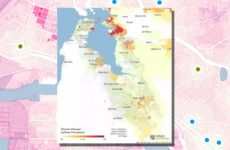
How Economic Advantage Comes to Geographically Mobile People
Katie Cordrey — January 11, 2009 — Business
References: amazon & creativeclass
Economic growth comes from people who have ideas, not from urban renewal projects, capital investment, ports, factories, or company location. This is the premise of Richard Florida’s latest book, Who’s Your City?
The people who have ideas are what Florida calls, “the creative class.” Florida has this to say about the sector:
Florida argues that where the creative class goes, innovation follows. He also says that individuals in the creative class don’t choose where they live based on money alone, but upon “quality of life” factors like a job they love, social connections, safe streets and good schools, economic and social opportunities, good governance, acceptance of diversity, and the aesthetic quality of place, the ability to connect with the natural world and enjoy the environment.
Once the creative class gains a critical mass in a community, they act as unwitting magnets for others who are attracted to the culture the creatives create. The video above is a talk he gave on the subject as a guest of “at Google Talks” in April 2008.
The founder of the Creative Class Group, Florida is an acclaimed economist who, after nearly three decades of study, has come to the conclusion that traditional economics misses much of the picture because it fails to adequately account for the human factor in its conclusions. Who’s Your City? is the 4th in a series of books. The Rise of the Creative Class was published in 2003, Cities and the Creative Class in 2004, and The Flight of the Creative Class in 2007.
The people who have ideas are what Florida calls, “the creative class.” Florida has this to say about the sector:
“The Creative Class describes 40 million workers--30 percent of the U.S. workforce--and includes two segments of workers: Creative Professionals - These professionals are the classic knowledge-based workers and include those working in healthcare, business and finance, the legal sector, and education… [and the] Super-Creative Core - These workers include scientists, engineers, techies, innovators, and researchers, as well as artists, designers, writers and musicians. The Creative Class is the core force of economic growth in our future economy. In fact, the Creative Class is expected to add more than 10 million jobs in the next decade.”
Florida argues that where the creative class goes, innovation follows. He also says that individuals in the creative class don’t choose where they live based on money alone, but upon “quality of life” factors like a job they love, social connections, safe streets and good schools, economic and social opportunities, good governance, acceptance of diversity, and the aesthetic quality of place, the ability to connect with the natural world and enjoy the environment.
Once the creative class gains a critical mass in a community, they act as unwitting magnets for others who are attracted to the culture the creatives create. The video above is a talk he gave on the subject as a guest of “at Google Talks” in April 2008.
The founder of the Creative Class Group, Florida is an acclaimed economist who, after nearly three decades of study, has come to the conclusion that traditional economics misses much of the picture because it fails to adequately account for the human factor in its conclusions. Who’s Your City? is the 4th in a series of books. The Rise of the Creative Class was published in 2003, Cities and the Creative Class in 2004, and The Flight of the Creative Class in 2007.
Trend Themes
1. Creative Class as Economic Growth Force - Opportunity to invest in cultivating a strong creative class presence and infrastructure to attract more innovative talent and foster economic growth in the community.
2. Quality of Life Factors in Location Choice - Opportunity to incorporate and promote quality of life factors, such as safe streets, good schools, and natural environment amenities, in urban development strategies and attract more talented individuals to the community.
3. Human Factors in Economic Growth - Opportunity to incorporate more human-centric approaches and analysis in economic growth strategies and policies.
Industry Implications
1. Education - Opportunity to develop more programs and initiatives in creative education institutions that cultivate a diverse range of skills and talents.
2. Real Estate - Opportunity to invest in urban development and real estate projects that prioritize quality of life factors, sustainability, and innovation.
3. Government - Opportunity to develop more policies and incentives that attract and retain creative talent and cultivate a vibrant creative community in the region.
2.6
Score
Popularity
Activity
Freshness















